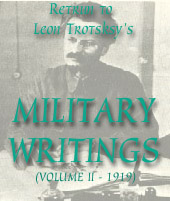
A battle is taking place on the Volga-Urals front. On one side are the workers and peasants – on the other, Kolchak’s bands, Blood is flowing, wealth, the fruit of the people’s labour is being destroyed, villages are being burnt, railway lines and bridges blown up. The fires of war, the dust and smoke of devastation raise a screen on the Eastern front. And why is all this happening? Because the former slave-owners, oppressors and exploiters do not want to live peaceful, laborious lives, but instead want to recover their hereditary rights to oppress and rob the working people.
But what is going on over there, behind the line of Kolchak’s front, behind the smokescreen of war, in the Urals and in the depths of Siberia? Who rules over there? What sort of order has been established there? We have received some very instructive information on that score. Every worker, every peasant, should reflect upon it.
Behind Kolchak’s back stretches, in a long narrow strip, the Trans-Siberian Railway, which runs to the great ocean. An immeasurable amount of labour and sacrifice was contributed by the working people of our country in order that the Trans Siberian line might be carried through the mountains and the dense forests. In whose hands is this railway now?
Not in the hands of the Siberian workers and peasants. But not in Kolchak’s either. The American, Japanese and French governments have disputed a great deal amongst themselves about which of them is to rule the roost on the Trans-Siberian. There are American units there, Japanese detachments, and the remains of the Czechoslovak corps, which consisted of mercenaries of the French bourgeoisie. In the end, the foreign imperialists decided that the Trans-Siberian should be control led by an inter-Allied, Anglo-Franco-Americano-Japanese commission. That is the situation today. The Trans-Siberian railway has ceased to be Siberian, it has become foreign: it serves not to unite the different parts of Siberia, and the whole of Siberia with Russia, but to enable foreign capitalists to plunder Siberia and carry away from it the riches they have plundered.
'6#8216;Siberia is a goldmine.’ This old popular saying characterised the uncountable natural riches of Siberia. There are deposits of gold, and fur-bearing animals, and grain, and cattle ... All this wealth ought to belong to the working masses of all Russia. But today Siberia, with its riches, has been torn from Russia and made the prey of foreign capitalist invaders. The Siberian workers and peasants are groaning. But even the terrible autocrat Kolchak has, in reality, no authority in Siberia. He is merely the executor of the orders of the American and Japanese stockbrokers. They need Kolchak only to separate Siberia from Russia. They will plunder Siberia for themselves.
In war, this happens: in order that one may regroup one’s forces without the enemy seeing, a thick smokescreen is created by firing off special smoke-shells. A cloud of smoke divides the surface of the land, and it is impossible to see through this smoke. It is also for the purpose of setting up such a smokescreen that the foreign capitalists need Kolchak. They give him money and shells for this purpose. They know that Siberia, that goldmine, will repay them with interest the capital thus laid out. And Kolchak performs his task with zeal: the smoke of hell rises over the Urals and the Volga country: thousands of workers and peasants are being slaughtered: villages and hamlets are being burned down: hundreds of millions’ worth of the people’s wealth is being turned into flame and ashes.
Behind this smokescreen the foreign vultures are carrying on their diabolical work: they are seizing the Trans-Siberian Rail way, taking possession of the gold-deposits, the forests and pastures, preparing to pillage Siberia to the very dregs. Once upon a time the Cossack Yermak conquered Siberia. [Western Siberia was conquered for Russia in the 1580s by Cossacks whose leader, the ataman Yermak, was backed by a powerful merchant family, the Stroganovs] Now, Admiral Kolchak is selling it. What do the interests of the Russian working people matter to Kolchak? Did Kolchak ever have anything in common with the working masses of the country? Did he ever fight alongside the working class and the peasantry against the oppressors? This is a Tsarist admiral who was concerned only about his career, who was ready at any moment to sell himself and his country’s wealth to the highest bidder: to Hindenburg, or Wilson, or Lloyd George, or Clemenceau, it was all the same to him. Kolchak found an employer, and undertook to conquer Siberia for exploitation by America. This is the meaning of the Cain’s work he is doing.
Behind the smokescreen raised by Kolchak there are, how ever, not only foreign thieves and vultures. There are the mill ions of workers and peasants of the Urals and Siberia. They look forward with passionate impatience to the time when the smokescreen will be dispersed and they will be able to reach out, through the Urals, the hand of friendship to workers’ and peasants’ Russia. Recovering Siberia for Russia means, first and foremost, returning Siberia to the Siberian workers and peasants.
We must carry through our task to the end, as quickly and decisively as we can. We must show, once and for all, to all the thugs, burglars and marauders, that Soviet Russia and Siberia are one great, common house of labour, with no entry for scoundrels. During this very spring we must ruthlessly, with the combined forces of the whole country, strangle the Kolchakite serpent. Then the Eastern smokescreen will be dispersed, the air will become transparent and clear over the Volga and the Urals, Soviet Siberia will join Soviet Russia, and the great Trans-Siberian railway will become what it ought to be: a great means for linking, economically and spiritually, the working masses of European Russia and Asiatic Russia.
En Route, No.32
April 18, 1919

Last updated on: 23.12.2006